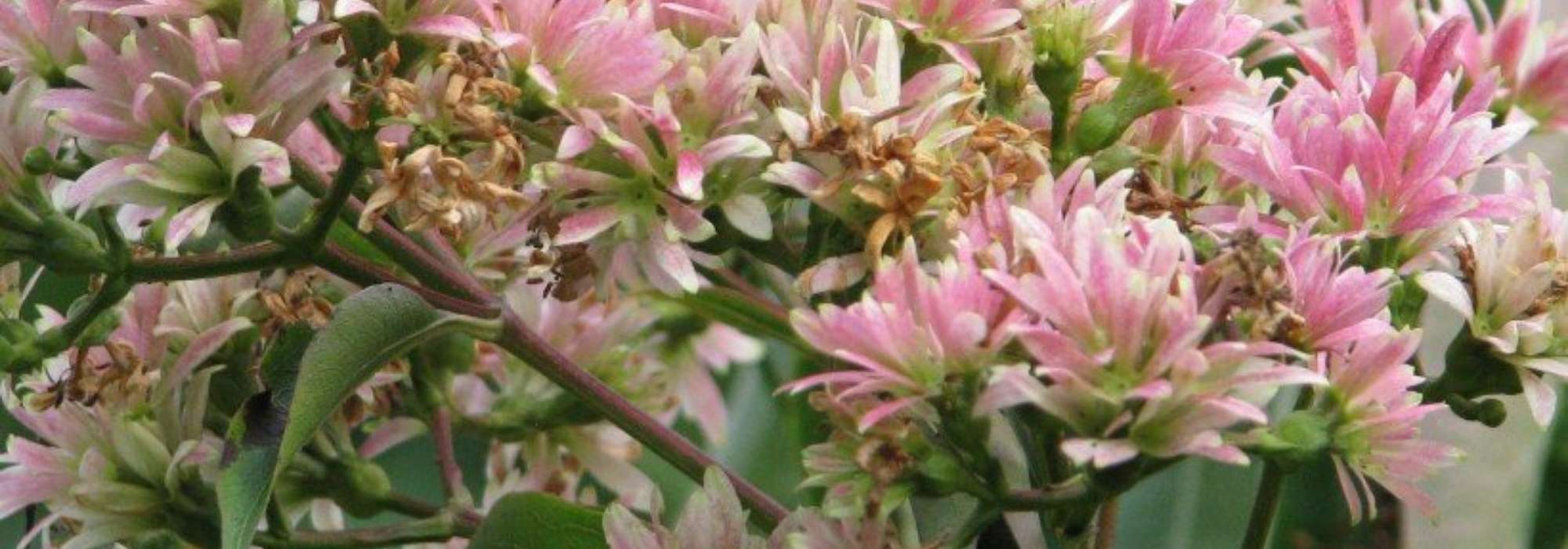
9 autumn-flowering shrubs
The best varieties
Contents
When the late season arrives, people often think of foliage turning warm colours, without considering that some bushes flower in autumn or carry on flowering! There are indeed several varieties of bushes whose flowering helps liven up late summer and autumn. This late flowering is a boon for the garden, which is adorned with off-season blooms and can be paired with perennials and deciduous bushes of autumn interest. Discover the best varieties that will accompany your garden with their colours right through to the first frosts.
Camellia sasanqua 'Choji Guruma': abundant flowering
Camellias are often associated with their superb spring flowering. Unique characteristic of sasanqua species is to flower from autumn through to early winter, thereby lighting up shaded beds where they are planted. Possessing the same characteristics as Camellia japonica, autumn camellias bear handsome glossy dark green evergreen leaves. While camellias are commonly associated with planting in heather soil, sasanqua are a little less demanding regarding soil type and exposure.
The Camellia sasanqua ‘Choji Guruma’ is a very handsome bush of about 1.50 m at ripeness, with an irregular habit. From September to November, it is covered in delightful double flowers in anemone form, with a heart of crumpled petals. Their light pink colour is marginate with darker pink at the edges. Its flowering is also slightly scented. Leaves are glossy and leathery, slightly dentate. It requires cool soil, can ideally be planted in partial shade, but tolerates deeper shade and sunny exposure. Camellia ‘Choji Guruma’ grows fairly slowly, like all camellias. If it flourishes fully in a shrub bed, in companion with other camellias with spring flowering, associated with rhododendrons, hydrangeas or Hamamelis, its small dimensions at ripeness also make it suitable for container planting on a terrace (it is hardy down to -10°C). In open ground, try a small tapetum of Cyclamen of Naples to accompany its beautiful flowering.
Read also
6 autumn camellias to discoverArbutus unedo 'Rubra': abundant vivid pink flowers
Arbutus unedo, strawberry tree, is an evergreen bush especially striking in autumn, when it begins a remarkable flowering of small bell-shaped blooms. It is easily recognised as belonging to the family Ericaceae by this singular flowering, like small swollen, trailing little bells grouped in clusters. Arbutus unedo ‘Rubra’ is notable for the colour of its small flowers, a lovely deep pink. It flowers between September and October, and is also melliferous and nectariferous at a time of year when pollinators have fewer food sources! Slightly more compact than the species (about 3 m across), it displays a bushy habit, dense leathery foliage and reveals very attractive reddish bark on a short trunk. Arbutus unedo is considered a bush for mild climates, but the cultivar ‘Rubra’ is a little more hardy, down to −15°C, making it an excellent choice for planting in many regions. Plant in a sunny position or in partial shade, in well-drained soil, dry or moist soil. It can even be grown in calcareous soil. Another notable advantage: this little strawberry tree becomes covered in red globose fruits, very decorative, which either fall before flowering or persist at the time of flowering.
When planted as a specimen, the strawberry tree ‘Rubra’ makes a striking subject. You can also plant it at the back of a border: it emphasises a Japanese touch in a Zen border, or suits more Mediterranean or exotic settings when planted with Pittosporum tobira ‘Nanum’, Agapanthus and euphorbias.
Discover other Late-flowering shrubs
View all →Available in 0 sizes
Available in 1 sizes
Available in 1 sizes
Available in 1 sizes
Available in 1 sizes
Available in 1 sizes
Available in 1 sizes
Available in 1 sizes
Available in 2 sizes
Available in 1 sizes
Clerodendrum trichotomum 'Variegatum': an intense fragrance
Clerodendron, or glory tree, is a marvellous deciduous bush with autumn flowering, still far too rare in our gardens! It has a bushy but airy habit and flowers between August and October depending on region. Besides the beauty of its flowers, it is one of the few bushes flowering in late summer to possess a delightful scent reminiscent of jasmine.
Clerodendrum trichotomum ‘Variegatum’ has the particularity of a superb variegated, downy foliage of green and yellow. The large veined leaves take on white tinges over time, which makes the bush particularly changeable and attractive even before flowering.
Flowers open between August and September, and remain on the tree in October in mild climates. They form in white, star-shaped and delightfully scented panicles, which gradually take on a pale mauve hue. The flowers transform into small, very unusual metallic blue berries, set on a calyx that has turned purple. Thus, alongside the beauty of the inflorescence, these distinctive fruits can be enjoyed for many more months. Originating from Japan, this variegated bush, sometimes called the “lucky bush”, tolerates temperatures down to -15°C, but is best planted in a sunny, sheltered position. It only dislikes soils that are too calcareous or too heavy. Once established, it becomes a standout bush in the garden, quite unique thanks to its large variegated foliage and spectacular flowering. We therefore recommend showcasing it by planting it on its own, or close to the house or beside a path to enjoy its fragrance. It can also bring originality and exoticism to a shrub bed, for example alongside the shimmering autumn foliage of a winged Euonymus and a Parrotia persica.
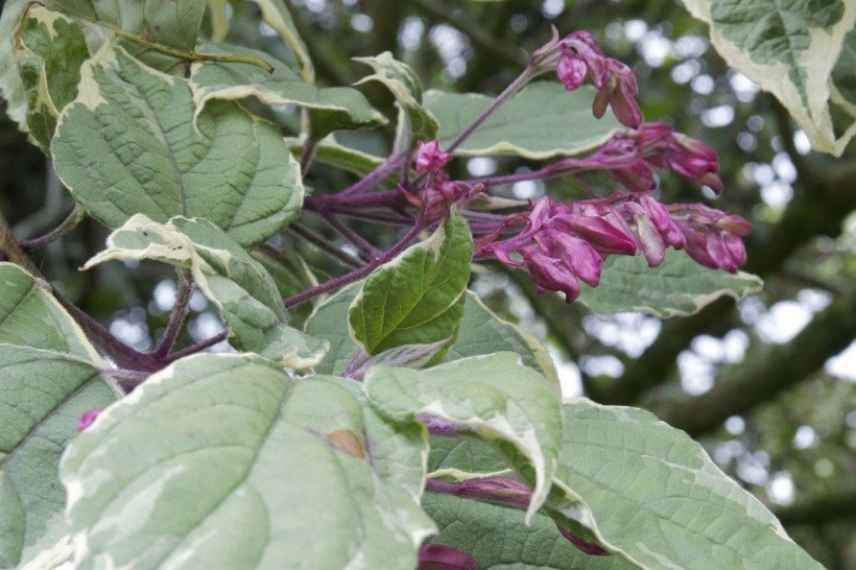
Clérodendron trichotonom ‘Variegatum’ has a soft and variagated folliage
Heptacodium miconioides: a fragrant rarity
Heptacodium miconioides is a little-known bush, yet it is one of the few to flower in late summer. In autumn, white petals fall, revealing colourful calyces that extend interest in this little gem. Foliage of this deciduous bush also turns a lovely yellow in autumn, is shed late in season, and its bark exfoliates with age, making it attractive right through to winter! Another major asset is that it is often grown as coppice shoots (multi-stemmed), giving it an original habit. Why not invite it into your garden when you also know it has exceptional hardiness?
Relatively modest in size (3 to 4 m), white flowers are divinely scented, melliferous and nectariferous — yet more advantages. Inflorescences appear in late August, taking over from many bushes that are finishing flowering. They form part of Heptacodium’s charm: a myriad of ivory-white, star-shaped flowers sit above graceful, arching foliage. They remain on the bush for about a month, usually in September, leaving a jasmine-scented trail. Calyces then remain in place and gradually turn pink, reaching purple tones by November. It is almost a second flowering, such is the spectacular and long-lasting burst of colour, as it persists until first frosts.
Heptacodium mionioides has no particular planting requirements. It thrives in all soils, even alkaline, provided they are well worked, and in full sun to partial shade.
For this bush with countless qualities, a prime position is required: as a specimen of course, or in a prominent place in a border that will serve as a setting and reveal its peeling trunk: perennials such as asters, sedums, and a few low shrubs (Choisya ‘Apple Blossom’). It can even be used as a small shade tree on a terrace, or trained into a topiary specimen!
→ Also discover Heptacodium ‘Temple of Bloom’, a compact form, in our blog article!
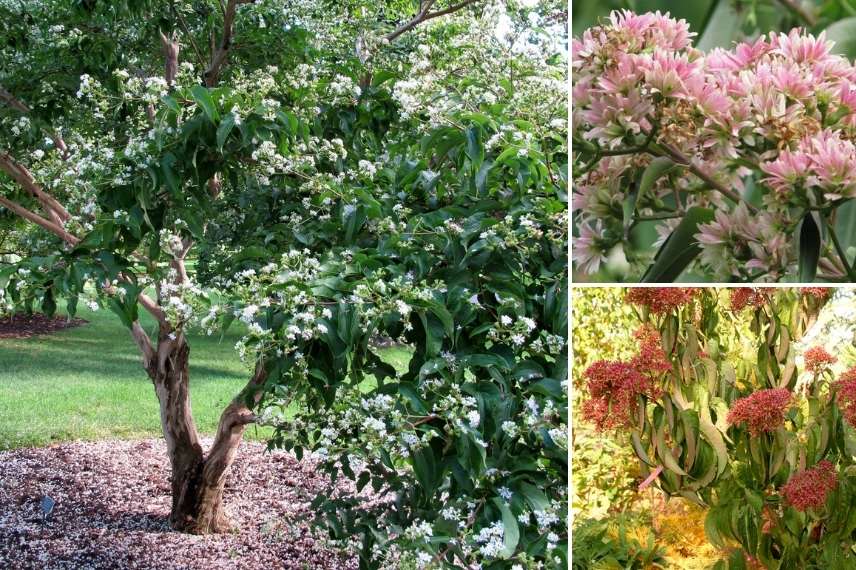
Heptacodion gives optimal flowering during a mild, sunny late season
Mahonia 'Soft Caress': exotic and non-prickly
Mahonias are not to everyone’s taste, to put it mildly… Yet they provide a very graphic, even exotic, touch to a corner of a garden, and usually display very bright yellow flowering in mid-winter. The Mahonia ‘Soft Caress’ is not lacking in appeal and might well make you change your mind: an evergreen bush, it already charms with foliage much finer and more dissected than the typical species, and, what’s more, without thorns. The colour of its foliage, an olive green with a slight bluish tinge, is superb. Smaller and more compact than other Mahonias (it grows to 1 m tall), it evokes a fern, with a dwarf conifer appearance.
Its very bright flowering rises in long yellow spikes from September until November, standing out particularly against the foliage. Do not expose it to too much sun, as this will shorten the life of its flowers; that would be a shame. Ideal: shade or partial shade. This small bush can be planted in a pot, where it will make an impact on a contemporary terrace. It is at its best, of course, in a border, bringing a Japonising or modern note, depending on accompanying plants: Helleborus orientalis, Heuchera ‘Pink Pearls’, Nandina domestica, Sorbaria sorbifolia, ferns…
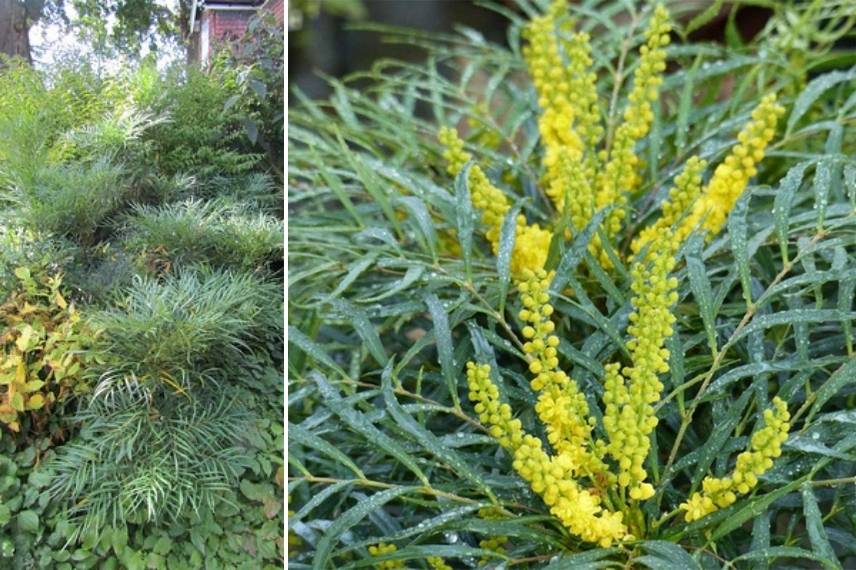
Mahonia ‘Soft Caress’
Lagestroemia indica 'Rhapsody in Pink': elegant and highly ornamental
The Lagerstroemia indica, or crape myrtle, is one of the most beautiful summer-flowering bushes. With flowering that can really extend into October, I include it here as a fine example of a bush with autumn flowering. All the more since its foliage gives it magnificent colouring before first frosts, and its peeling bark is worth seeing in winter, when it becomes a striking architectural specimen in the garden.
The crape myrtle ‘Rhapsody in Pink’ of course has all these qualities. Slightly shorter than the typical species (about 2.50 m at ripeness), its flowering is a very deep pink. It is mainly covered with huge clusters of flowers with crumpled petals 40 cm long, which stand out from the purplish shoots. They will fade as they open, until October when they will become almost white before fading. Its foliage, purple in spring, greens then takes on orange hues that look splendid in autumn. Plant in full sun, but can tolerate slightly less sunlight than its relatives. Its elegance predisposes it to being planted as a specimen, to showcase its habit, as a standard or in coppice shoots. It can also be planted in a perennial border at its feet, in a colour range of pinks and whites, punctuated with purple and glaucous foliage (Physocarpus opulifolius ‘Little Angel’, Elymus arenarius ‘Glaucus’)
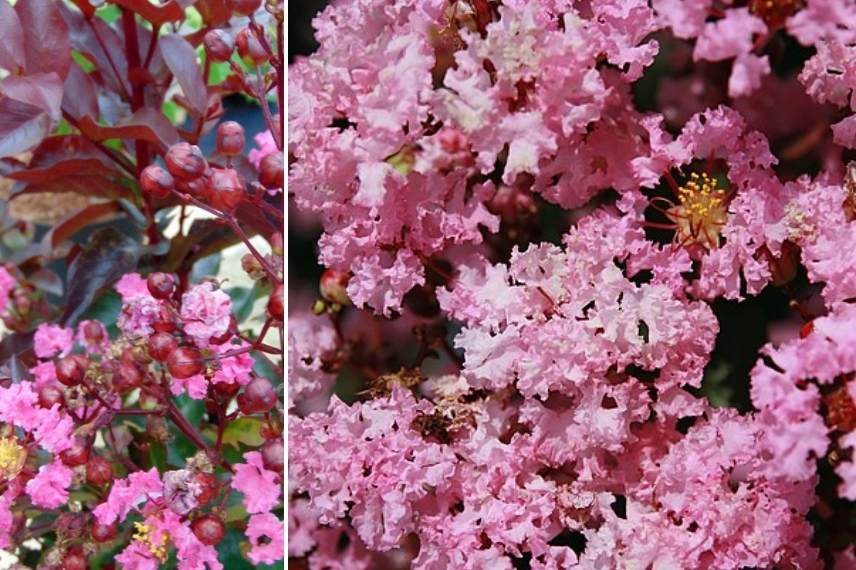
Lagerstroemia ‘Rhapsody in Pink’: rootlets and inflorescences (Photo: David J Stang)
Osmanthus fragrans var. aurantiacus: a unique colour and fragrance
Here is a small specimen of the genus Osmanthus that will not leave you indifferent: this bush becomes covered with orange inflorescences gathered in small clusters along the branches, which give off a powerful scent in September and October. This flowering is unique, with a vibrant colour rare at this time of year, making it a very ornamental bush. It starts in early summer and continues into autumn. The fragrant osmanthus, also called Chinese olive, is a bush with evergreen foliage, but without the thorns often present in osmanthus species. Planted in a sheltered spot, ideally in partial shade and certainly out of direct sun, it becomes a magnificent large bush about 4 m tall. Humus-rich soils suit it particularly well, acidic or neutral, and normally well-drained, always mulched at the start of growth. Only drawback: it is a mild-climate species, tolerating cold down to only -5°C. Place it near a path or a house if you can tolerate its intense scent (its essential oil is used in perfumery), or in a flowering hedge or shrub border. It pairs well with winter white flowerings (Garrya eliptica, Sarcococca) or yellow ones (Mahonias), and with variegated foliage such as Eleagnus, for example.
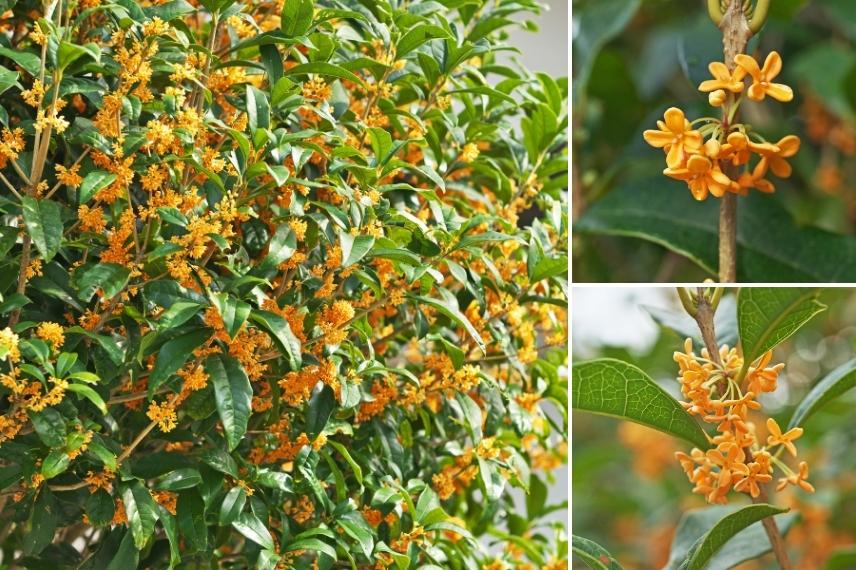
Fragrant osmanthus whose warm colours brighten autumn
Abelia chinensis: an irresistible charmer
If any bush is indispensable in the garden for its flowering, it is Abelia! It is one of those that flowers for the longest time, hence its value in our gardens to prolong summer a little longer. Among around thirty species of genus Abelia, the Abelia chinensis or Chinese Abelia is a delightful species, producing generously from early summer white flowers with a matte pink calyx, tubular in shape, delicately scented. In mild climates they often persist until November. With an arched habit, branches bowing under the profusion of flowers, it is semi-evergreen, or evergreen in mild climates. This long flowering is accompanied in autumn by a change of colour of foliage and branches, turning bronze and purple, which adds to its charm. It can therefore be used in splendid autumn bouquets. Small in size (1.5 m to 2 m), it can occupy many garden spaces, either as an informal hedge or in a shrub border, in full sun to partial shade, in well-drained soil. It brings real charm and a romantic note to a garden. Once established, one of its other advantages is that it tolerates drought very well. Plant with flowering bushes with a free-growing habit such as lilacs, weigelas, laurustinus, kolkwitzias, ceanothuses, etc.
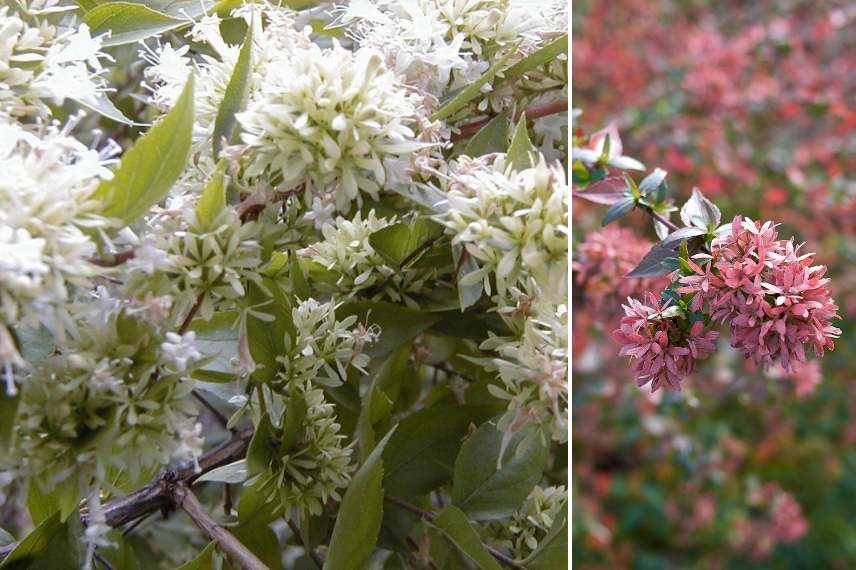
Utterly charming Abelia chinensis
Viburnum tinus 'Purpureum': long-lasting flowering
Laurustinus (Viburnum tinus) bushes are evergreen bushes, well known to gardeners, often used as informal hedging in gardens. Introduced here and there into the garden, they have the great advantage of flowering early in autumn, from mid-October, and of bringing a lovely creamy-pink colouring to borders and hedges. Their long flowering until spring makes them an indispensable bush for adding colour to the landscape during the duller months.
La Viburnum tinus ‘Purpureum’ is an interesting cultivar because of the colour of its leaves, which gives a fresh twist to the genus. It differs from other laurustinus by the bronze-purplish colour of its young leaves in spring. These turn dark green for the rest of the year, with a slight down on the margins of the leaves. Viburnum tinus ‘Purpureum’ is also characterised by a more compact habit, not exceeding 2 m.
Depending on region, pink flower buds appear in October and open into delicate umbels in soft white and pink shades. The great appeal of these inflorescences, beyond their charmingly rustic aspect, is their presence throughout the long winter months: flowers keep appearing until April. Garden benefits greatly, especially as the flowers are followed by blue berries much prized by birds.
Easy to grow, Viburnum tinus ‘Purpureum’ has few requirements, grows almost anywhere, and tolerates all aspects! Another reason not to be without it, and to mix it harmoniously with other flowering or non-flowering bushes, in a dividing hedge or in an informal hedge. It will be perfect alongside Abelias, Ligustrums, shrubby honeysuckles, milky Cotoneasters or Cotinus.
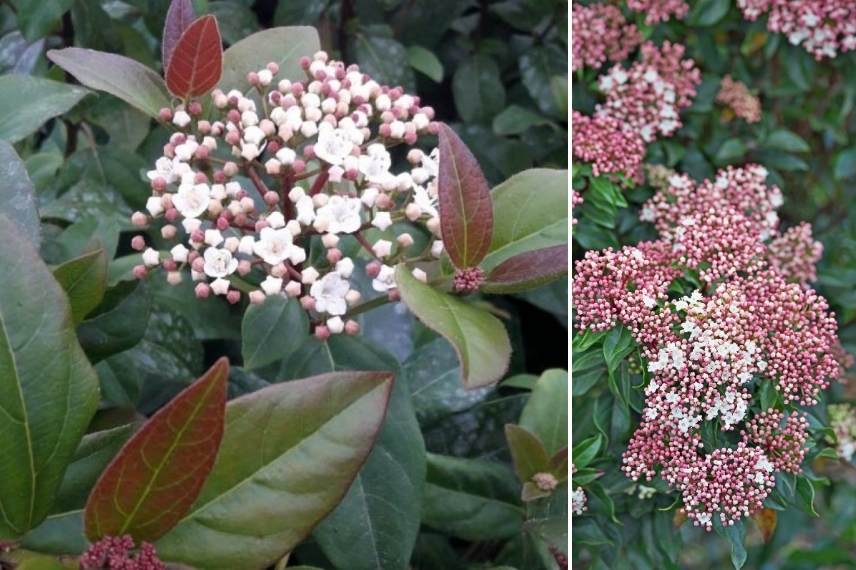
Viburnum tinus ‘Purpureum’ and its beautiful rounded creamy-pink umbels
- Subscribe!
- Contents
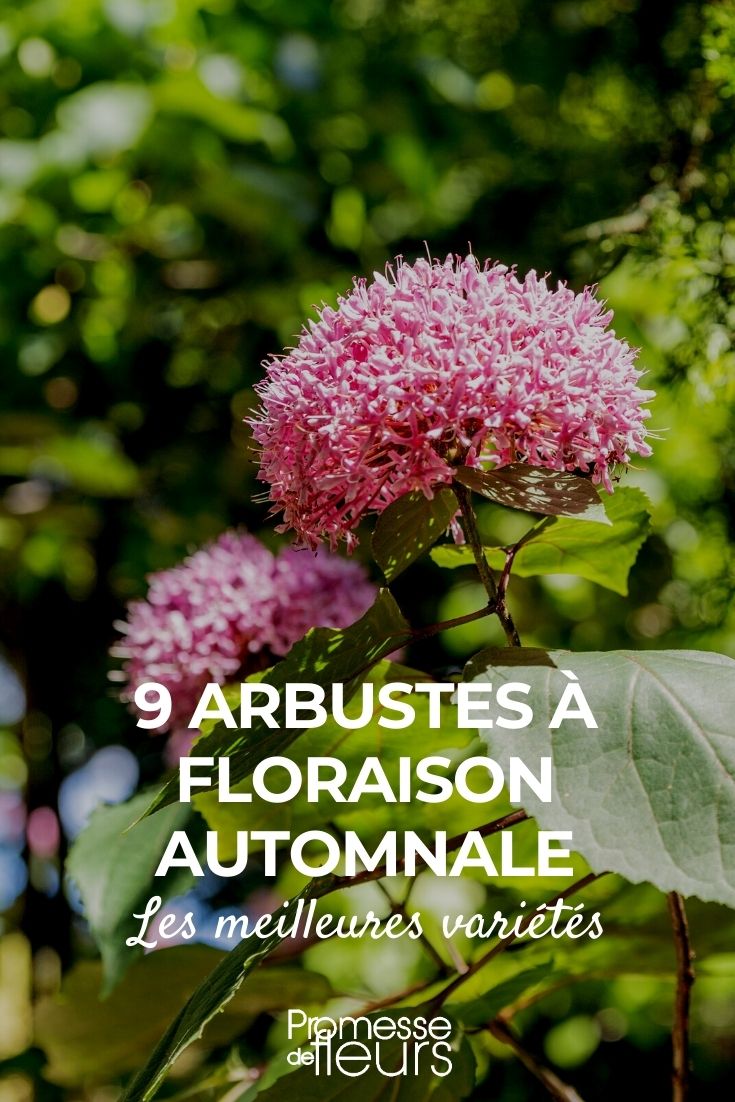































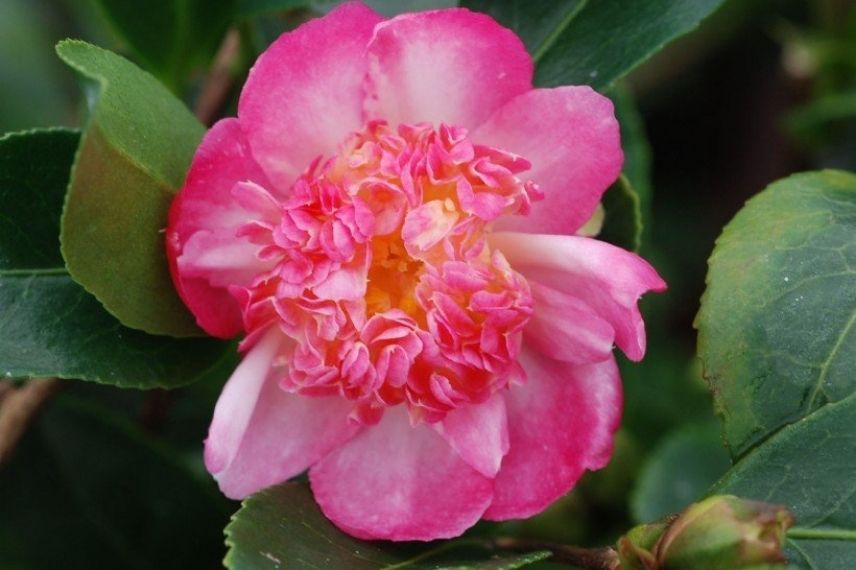
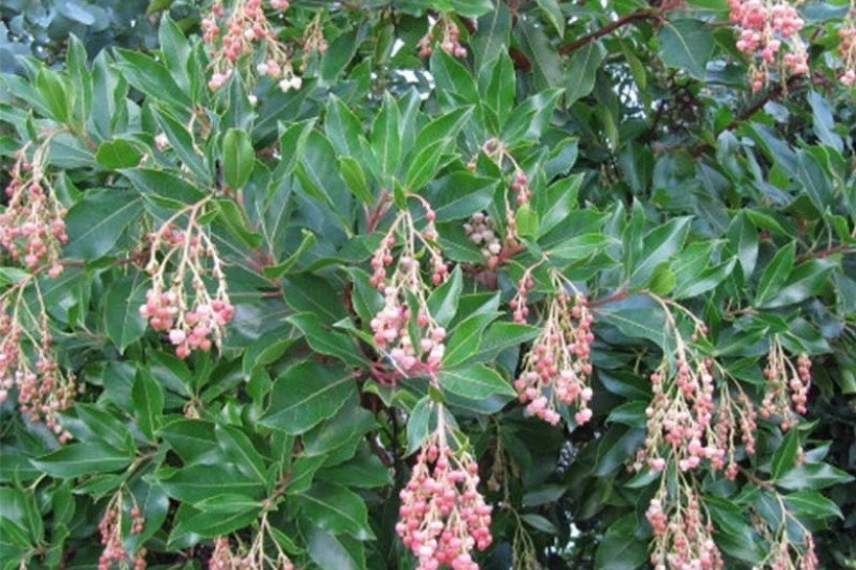




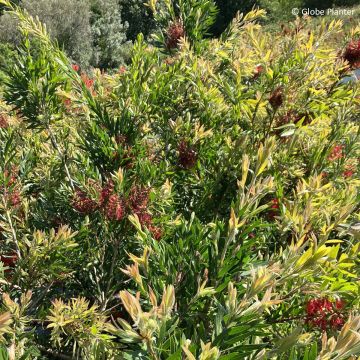
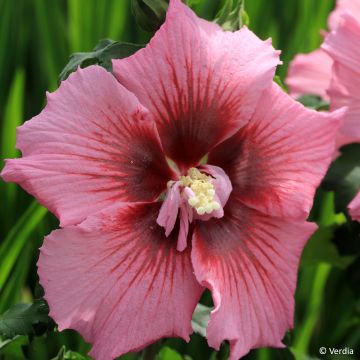
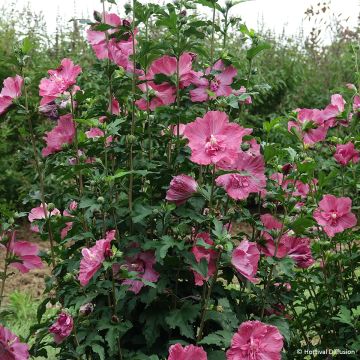


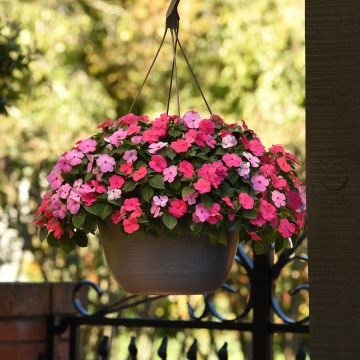
Comments